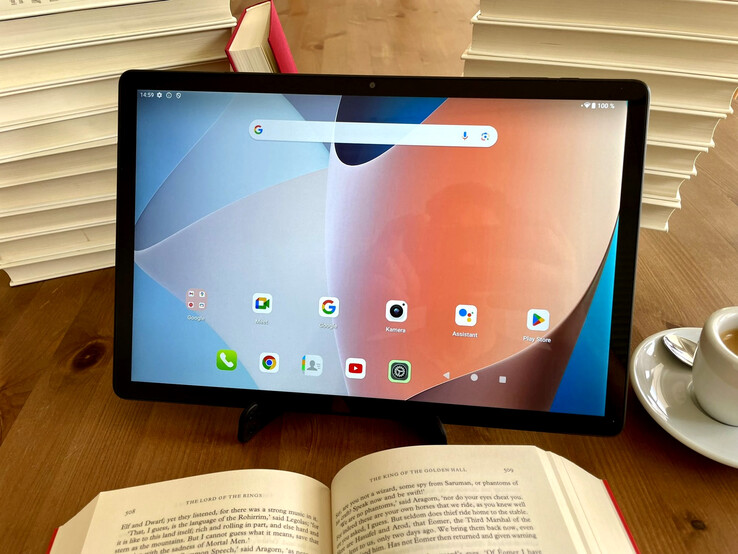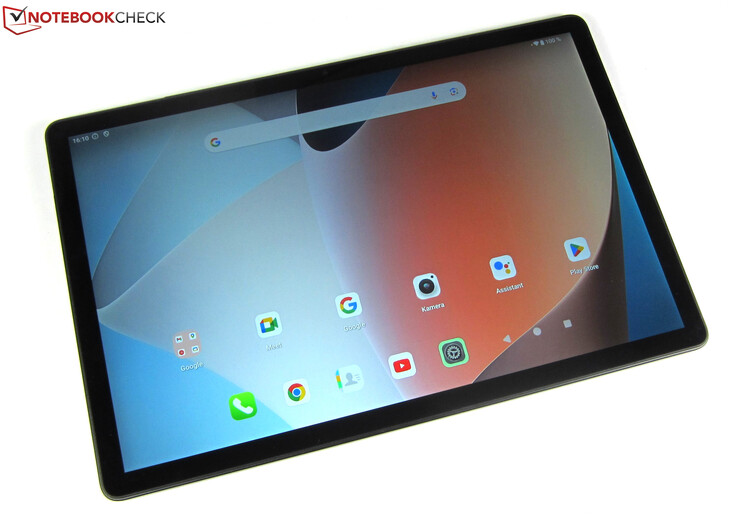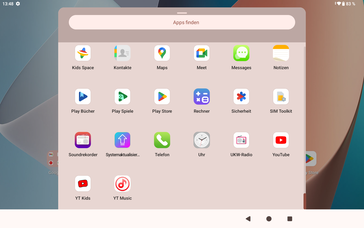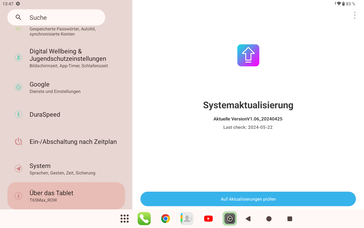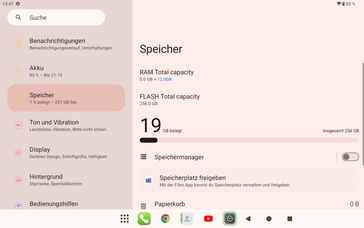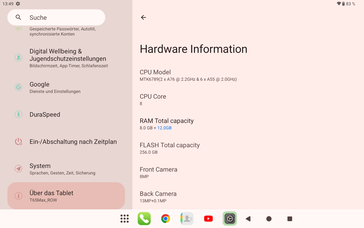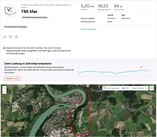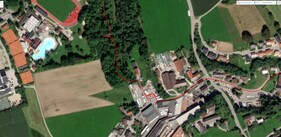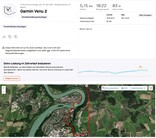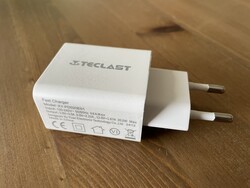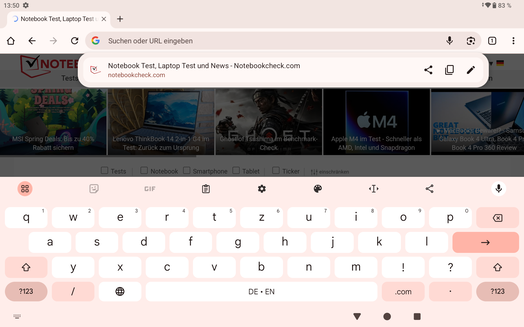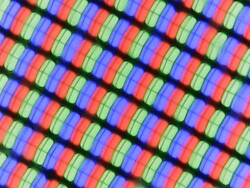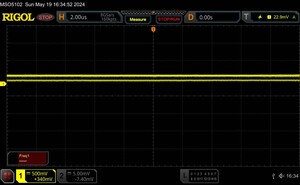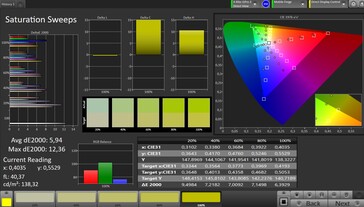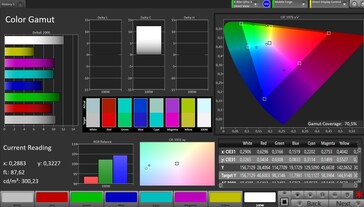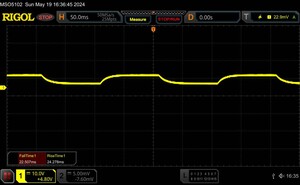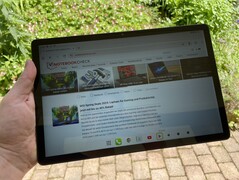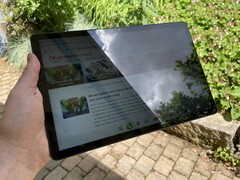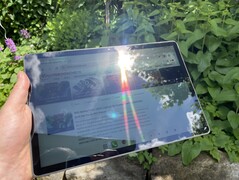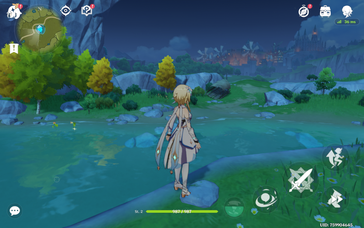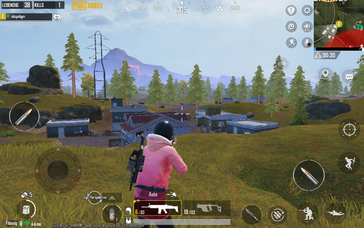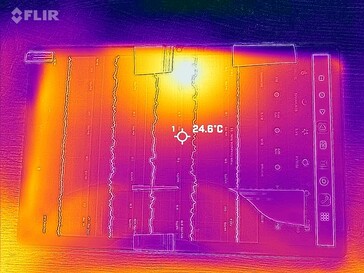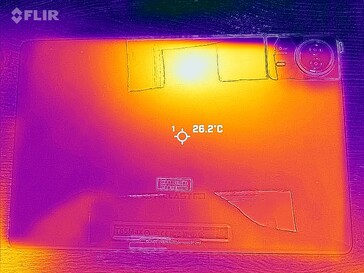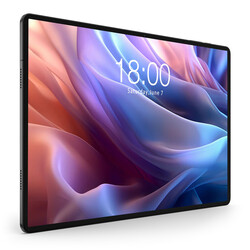Teclast T65 Max review - A 13-inch tablet at a bargain price
Tablets larger than 12 inches in size offer lots of screen surface for watching videos and surfing the web, but they are also one thing above all: expensive. The T65 Max, made by the Chinese manufacturer Teclast, is now attempting the complete opposite. The Android 14 tablet has a screen diagonal of 12.95 inches, meaning it is as big as the Apple iPad Pro 12.9—but its price starts as low as under US$400.
The T65 Max is Teclast's largest tablet so far and despite its comparatively low price, it comes with quite a few features. Aside from an IPS display with a 1920 x 1200 pixel resolution, it also comes with 256 GB storage, a 4G modem, a 10,000-mAh battery, four speakers, and the MediaTek Helio G99—a solid mid-range SoC. Let's take a look at who this tablet is made for.
Possible competitors compared
Rating | Date | Model | Weight | Height | Size | Resolution | Price |
|---|---|---|---|---|---|---|---|
| 81.2 % v7 (old) | 05 / 2024 | Teclast T65 Max Helio G99, Mali-G57 MP2 | 710 g | 8.2 mm | 12.95" | 1920x1200 | |
| 84.8 % v7 (old) | 03 / 2024 | Honor Pad 9 SD 6 Gen 1, Adreno 710 | 555 g | 6.96 mm | 12.10" | 2560x1600 | |
| 86.5 % v7 (old) | 09 / 2023 | Huawei MatePad 11.5 SD 7 Gen 1, Adreno 644 | 499 g | 6.85 mm | 11.50" | 2200x1440 | |
| 85.2 % v7 (old) | 09 / 2023 | Lenovo Tab P12 Dimensity 7050, Mali-G68 MP4 | 615 g | 6.9 mm | 12.70" | 2944x1840 | |
| 80.7 % v7 (old) | 01 / 2024 | Teclast T60 T7255 (T616), Mali-G57 MP1 | 570 g | 7.7 mm | 11.97" | 2000x1200 |
Case - The T65 Max with a matte aluminum unibody case
Thanks to its matte-gray aluminium unibody case, the 12.95-inch T65 Max looks high-quality and is built well.
On the other hand, if you apply pressure, then you can twist the Teclast tablet quite easily, which is met with some creaking noises. Even so, the T65 Max is definitely stable enough for everyday use. In turn, it doesn't feature an IP certification.
The Teclast tablet, which is nice and slim at only 8.2 mm in thickness, isn't the most lightweight due to its XXL size—we measured 710 grams. Still, its bezels (1 cm wide) allow you to hold the tablet comfortably without accidentally activating the touchscreen. The volume rocker and power button allow a little lateral flex and have a crisp pressure point.
The main camera, with its eye-catching high-shine bezels, draws all attention to the back of the tablet. Embedded in this are two lenses which both protrude from the back cover by about 2 millimetres. Thankfully, the tablet doesn't wobble when placed on a flat surface thanks to its enormous size.
Connectivity - 256 GB storage on the Teclast tablet
Teclast has equipped the T65 Max with 8 GB LPDDR4X RAM and 256 GB UFS 2.2 storage. Its RAM can be expanded to up to 20 GB, but not physically—instead, via a 6 to 12 GB swap file in the storage. As this works much slower than the RAM, this memory expansion ultimately remains a marketing gimmick with no practical benefit.
The T65 Max's USB-C port runs at USB-2.0 speeds and supports USB-OTG, allowing you to connect USB drives to the tablet, for example. A further option to expand the internal storage is by using the microSD card slot, which can accommodate cards up to 1 TB in size. If you don't reach for a microSD card, then you can also insert two nano SIM cards into the hybrid slot. The device also features a 3.5-mm jack with which you can connect external audio devices.
microSD card reader
Using our Angelbird AV Pro V60 as a microSD reference card, we noted the card reader to deliver good speeds slightly above those of its sister model, the Teclast T60. The Lenovo Tab P12 did the worst amongst the comparison devices, lagging behind the Teclast T65 Max in both sequential data throughput and the copying test.
| SD Card Reader - average JPG Copy Test (av. of 3 runs) | |
| Teclast T65 Max (Angelbird V60) | |
| Teclast T60 (Angelbird V60) | |
| Lenovo Tab P12 (Angelbird AV Pro V60) | |
Cross Platform Disk Test (CPDT)
Software - The Teclast T65 Max with stock Android 14
The latest version of Android, namely Android 14, runs on the T65 Max. No third-party apps come preinstalled, meaning the available storage space can be used very effectively. The Teclast tablet supports DRM Widevine L1, so it can play copy-protected streaming content from Netflix and co in HD.
At the time of testing at the end of May, the tablet ran using the system build 1.06_20240425 whose Android security patches were from February 5th 2024, so not totally up to date. Unfortunately, Teclast hasn't given any information on how long the T65 Max is set to receive OS upgrades and security patches, and how frequently these will be delivered.
Communication and GNSS - WiFi 5 and an LTE modem
The T65 Max uses WiFi 5 as its fastest Wi-Fi standard. Using our reference router Asus ROG Rapture GT-AXE11000 as a remote station, the T65 Max achieved good and stable transfer rates that roughly corresponded to the maximum data throughput possible with WiFi 5. It was surpassed by comparable devices such as the Huawei MatePad 11.5 and the Lenovo Tab P12, both of which already make use of WiFi 6.
The T65 Max's communication features also include Bluetooth 5.0 and a 4G mobile module. This supports the LTE bands 1, 3, 5, 7, 8, 20, 34, 38, 39, 40 and 41, ensuring good reception in the EU, where this test was carried out.
| Networking | |
| Teclast T65 Max | |
| iperf3 receive AXE11000 | |
| iperf3 transmit AXE11000 | |
| Honor Pad 9 | |
| iperf3 receive AXE11000 | |
| iperf3 transmit AXE11000 | |
| Huawei MatePad 11.5 | |
| iperf3 receive AXE11000 | |
| iperf3 transmit AXE11000 | |
| Lenovo Tab P12 | |
| iperf3 receive AXE11000 | |
| iperf3 transmit AXE11000 | |
| Teclast T60 | |
| iperf3 receive AXE11000 | |
| iperf3 transmit AXE11000 | |
The T65 Max uses the satellite navigation services GPS (L1), Glonass (L1), Galileo (E1) and Beidou (B1) to determine its position. Inside buildings, the tablet was able to locate us to within 2 meters, and outdoors to within 1 meter.
During the practical test, the T65 Max showed itself to be suitable for navigation tasks—provided you are willing to use a giant tablet for this. In comparison with the Garmin Venu 2 fitness smartwatch, the Teclast didn't record our route within an urban environment quite as accurately. In less densely populated areas, however, the T65 Max was almost as accurate as the Garmin smartwatch.
Cameras - Okay for snapshots
The T65 Max's selfie camera has a resolution of 8 megapixels, uses a fixed focus and delivers acceptable results—provided there is sufficient ambient light. Its image quality is also fine for video calls in Full HD.
The Teclast tablet's main camera features a resolution of 13 MP and, unlike the selfie camera, is supported by autofocus and an LED flash. There are two identical-looking lenses on the back cover. However, the lower of the two cannot be actively used, as it only works as a depth sensor for the 13 MP main camera.
The main camera's picture quality is fine for occasional snapshots. It can capture image details quite well, but mixes this with rather low-contrast depiction. You should avoid zooming in on images, as they will quickly become blurred. Shooting in low light conditions also demands too much from the camera.
The main camera can record videos at up to 2560 x 1440 pixels and at 30 frames per second, resulting in an image quality comparable to that of its photos. Alternatively, you can also switch to Full HD or 720p.
Image comparison
Choose a scene and navigate within the first image. One click changes the position on touchscreens. One click on the zoomed-in image opens the original in a new window. The first image shows the scaled photograph of the test device.
Daylight photo 1Daylight photo 2Low-light photoUnder controlled lighting conditions, the main camera showed that it is able to capture colors quite accurately. However, even with optimal studio lighting, it had difficulties capturing the test chart in focus. At 1 lux of residual light, the camera no longer achieved any meaningful results—the ColorChecker color chart and the test chart were no longer visible.
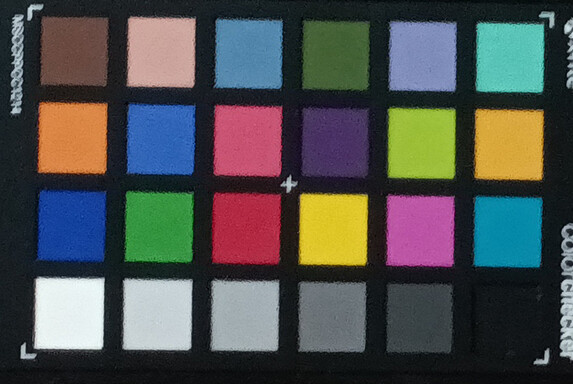

Accessories and warranty - A 20-watt power supply and an optional folio case
The Teclast T65 Max's scope of delivery includes a 20-watt power supply (12V/1,67A), USB-C cable, SIM tool, short instruction manual and a warranty card. The manufacturer also offers an optional folio case which you can purchase via its website.
The Teclast T65 Max is covered by a 12-month warranty.
Inout devices & operation - Facial recognition, but no fingerprint sensor
The T65 Max's touchscreen works well and inputs are recognized precisely along the edges and right into the corners. The eight-core Mediatek Helio G99 SoC gives the tablet a high system speed that doesn't sink even with multiple apps open at once. Due to its 60-Hz refresh rate, however, depiction on its screen isn't quite as smooth as it could be.
The T65 Max doesn't have a fingerprint sensor. This means you can only sign in biometrically using 2D facial recognition—this works well in adequate lighting conditions. Further sign-in options include patterns, PINs and passwords.
Display - Dim IPS panel without PWM
The T65 Max's 12.95-inch IPS panel has a resolution of 1920 x 1200 pixels. It therefore features a 16:10 aspect ratio and achieves a pixel density of 175 PPI. The display does not support HDR.
With a white background, the IPS panel showed an average brightness of 289.6 cd/m². When the measurement was repeated with evenly distributed light and dark image areas (APL18), the screen's brightness increased to up to 328 cd/m².
The IPS panel's luminance is easily sufficient for indoor use, but it may not be quite enough if you want to use the tablet outdoors. In addition, all competing tablets in this comparison offer better brightness—in particular the Honor Pad 9, which manages up to 613 cd/m².
The Teclast T65 Max is well suited for users who are sensitive to PWM flickering, as it doesn't use pulse width modulation for brightness control.
| |||||||||||||||||||||||||
Brightness Distribution: 87 %
Center on Battery: 296 cd/m²
Contrast: 630:1 (Black: 0.47 cd/m²)
ΔE ColorChecker Calman: 7.1 | ∀{0.5-29.43 Ø4.78}
ΔE Greyscale Calman: 8 | ∀{0.09-98 Ø5}
90.3% sRGB (Calman 2D)
Gamma: 2.204
CCT: 7992 K
| Teclast T65 Max IPS, 1920x1200, 13" | Honor Pad 9 IPS LCD, 2560x1600, 12.1" | Huawei MatePad 11.5 IPS, 2200x1440, 11.5" | Lenovo Tab P12 LTPS, 2944x1840, 12.7" | Teclast T60 IPS, 2000x1200, 12" | |
|---|---|---|---|---|---|
| Screen | 69% | 43% | 40% | 53% | |
| Brightness middle (cd/m²) | 296 | 613 107% | 472 59% | 435 47% | 352 19% |
| Brightness (cd/m²) | 290 | 570 97% | 432 49% | 407 40% | 324 12% |
| Brightness Distribution (%) | 87 | 87 0% | 86 -1% | 89 2% | 88 1% |
| Black Level * (cd/m²) | 0.47 | 0.4 15% | 0.44 6% | 0.58 -23% | 0.25 47% |
| Contrast (:1) | 630 | 1533 143% | 1073 70% | 750 19% | 1408 123% |
| Colorchecker dE 2000 * | 7.1 | 2.7 62% | 3.4 52% | 1.5 79% | 2.6 63% |
| Colorchecker dE 2000 max. * | 22.2 | 5.1 77% | 6.6 70% | 3.2 86% | 5.75 74% |
| Greyscale dE 2000 * | 8 | 3.7 54% | 4.8 40% | 2.4 70% | 1.5 81% |
| Gamma | 2.204 100% | 2.3 96% | 2.41 91% | 2.2 100% | 2.319 95% |
| CCT | 7992 81% | 6763 96% | 7035 92% | 6546 99% | 6747 96% |
* ... smaller is better
Screen Flickering / PWM (Pulse-Width Modulation)
| Screen flickering / PWM not detected | |||
In comparison: 53 % of all tested devices do not use PWM to dim the display. If PWM was detected, an average of 8111 (minimum: 5 - maximum: 343500) Hz was measured. | |||
Measurement series with fixed zoom level and different brightness settings
Using the factory-set color mode standard (warm and cool can also be selected), the IPS panel's color reproduction is slightly off the ideal line. It shows a clear blue cast and only manages a poor contrast ratio of 630:1 due to its high black value of 0.47 cd/m². Its low color accuracy isn't that noticeable to the naked eye, but its somewhat pale display is.
Display Response Times
| ↔ Response Time Black to White | ||
|---|---|---|
| 22.1 ms ... rise ↗ and fall ↘ combined | ↗ 12.8 ms rise | |
| ↘ 9.3 ms fall | ||
| The screen shows good response rates in our tests, but may be too slow for competitive gamers. In comparison, all tested devices range from 0.1 (minimum) to 240 (maximum) ms. » 49 % of all devices are better. This means that the measured response time is similar to the average of all tested devices (20.2 ms). | ||
| ↔ Response Time 50% Grey to 80% Grey | ||
| 46.7 ms ... rise ↗ and fall ↘ combined | ↗ 22.5 ms rise | |
| ↘ 24.2 ms fall | ||
| The screen shows slow response rates in our tests and will be unsatisfactory for gamers. In comparison, all tested devices range from 0.165 (minimum) to 636 (maximum) ms. » 80 % of all devices are better. This means that the measured response time is worse than the average of all tested devices (31.6 ms). | ||
Performance - The Teclast T65 Max with a MediaTek Helio G99
The MediaTek Helio G99 from 2022 in no way turns the T65 Max into a performance high-flyer, but the SoC's performance is easily sufficient for multimedia uses and web surfing. The tablet only reaches its limits running very complex apps. There are a number of tablets in this price range that are significantly faster. The Huawei MatePad 11.5 and the Lenovo Tab P12, for example, offer more power.
| Antutu v10 - Total Score | |
| Average of class Tablet (164396 - 3475590, n=70, last 2 years) | |
| Honor Pad 9 | |
| Average Mediatek Helio G99 (383511 - 422936, n=9) | |
| Teclast T65 Max | |
| Teclast T60 | |
| Antutu v9 - Total Score | |
| Huawei MatePad 11.5 | |
| Average of class Tablet (126757 - 1247557, n=14, last 2 years) | |
| Lenovo Tab P12 | |
| Teclast T65 Max | |
| Average Mediatek Helio G99 (229468 - 375956, n=8) | |
| Teclast T60 | |
| CrossMark - Overall | |
| Average of class Tablet (227 - 2155, n=54, last 2 years) | |
| Honor Pad 9 | |
| Lenovo Tab P12 | |
| Average Mediatek Helio G99 (526 - 602, n=14) | |
| Teclast T65 Max | |
| Teclast T60 | |
| AImark - Score v3.x | |
| Average of class Tablet (138 - 55794, n=52, last 2 years) | |
| Average Mediatek Helio G99 (842 - 1001, n=10) | |
| Teclast T65 Max | |
| Huawei MatePad 11.5 | |
| Honor Pad 9 | |
| Lenovo Tab P12 | |
| Teclast T60 | |
| UL Procyon AI Inference for Android - Overall Score NNAPI | |
| Average of class Tablet (2597 - 76852, n=62, last 2 years) | |
| Huawei MatePad 11.5 | |
| Teclast T65 Max | |
| Average Mediatek Helio G99 (6323 - 9695, n=13) | |
| Honor Pad 9 | |
| Lenovo Tab P12 | |
| Teclast T60 | |
The MediaTek Helio G99's ARM Mali-G57 MC2 provides the T65 Max with solid graphics performance. As the GFXBench tests showed, you can even run games smoothly in higher detail settings.
GFXBench (DX / GLBenchmark) 2.7: T-Rex Onscreen | 1920x1080 T-Rex Offscreen
GFXBench 3.0: on screen Manhattan Onscreen OGL | 1920x1080 1080p Manhattan Offscreen
GFXBench 3.1: on screen Manhattan ES 3.1 Onscreen | 1920x1080 Manhattan ES 3.1 Offscreen
GFXBench: on screen Car Chase Onscreen | 1920x1080 Car Chase Offscreen | on screen Aztec Ruins High Tier Onscreen | 2560x1440 Aztec Ruins High Tier Offscreen | on screen Aztec Ruins Normal Tier Onscreen | 1920x1080 Aztec Ruins Normal Tier Offscreen | 3840x2160 4K Aztec Ruins High Tier Offscreen
| 3DMark / Wild Life Extreme Unlimited | |
| Huawei MatePad 11.5 | |
| Lenovo Tab P12 | |
| Honor Pad 9 | |
| Teclast T65 Max | |
| Teclast T60 | |
| 3DMark / Wild Life Extreme | |
| Huawei MatePad 11.5 | |
| Lenovo Tab P12 | |
| Honor Pad 9 | |
| Teclast T65 Max | |
| Teclast T60 | |
| 3DMark / Wild Life Unlimited Score | |
| Huawei MatePad 11.5 | |
| Honor Pad 9 | |
| Lenovo Tab P12 | |
| Teclast T65 Max | |
| Teclast T60 | |
| 3DMark / Wild Life Score | |
| Huawei MatePad 11.5 | |
| Honor Pad 9 | |
| Lenovo Tab P12 | |
| Teclast T65 Max | |
| Teclast T60 | |
| 3DMark / Sling Shot Extreme (ES 3.1) Unlimited | |
| Huawei MatePad 11.5 | |
| Lenovo Tab P12 | |
| Teclast T65 Max | |
| Teclast T60 | |
| 3DMark / Sling Shot Extreme (ES 3.1) Unlimited Graphics | |
| Huawei MatePad 11.5 | |
| Lenovo Tab P12 | |
| Teclast T65 Max | |
| Teclast T60 | |
| 3DMark / Sling Shot Extreme (ES 3.1) Unlimited Physics | |
| Huawei MatePad 11.5 | |
| Lenovo Tab P12 | |
| Teclast T65 Max | |
| Teclast T60 | |
| GFXBench (DX / GLBenchmark) 2.7 / T-Rex Onscreen | |
| Huawei MatePad 11.5 | |
| Honor Pad 9 | |
| Lenovo Tab P12 | |
| Teclast T65 Max | |
| Teclast T60 | |
| GFXBench (DX / GLBenchmark) 2.7 / T-Rex Offscreen | |
| Huawei MatePad 11.5 | |
| Honor Pad 9 | |
| Lenovo Tab P12 | |
| Teclast T65 Max | |
| Teclast T60 | |
| GFXBench 3.0 / Manhattan Onscreen OGL | |
| Huawei MatePad 11.5 | |
| Teclast T65 Max | |
| Honor Pad 9 | |
| Lenovo Tab P12 | |
| Teclast T60 | |
| GFXBench 3.0 / 1080p Manhattan Offscreen | |
| Huawei MatePad 11.5 | |
| Lenovo Tab P12 | |
| Honor Pad 9 | |
| Teclast T65 Max | |
| Teclast T60 | |
| GFXBench 3.1 / Manhattan ES 3.1 Onscreen | |
| Huawei MatePad 11.5 | |
| Honor Pad 9 | |
| Teclast T65 Max | |
| Lenovo Tab P12 | |
| Teclast T60 | |
| GFXBench 3.1 / Manhattan ES 3.1 Offscreen | |
| Huawei MatePad 11.5 | |
| Honor Pad 9 | |
| Lenovo Tab P12 | |
| Teclast T65 Max | |
| Teclast T60 | |
| GFXBench / Car Chase Onscreen | |
| Huawei MatePad 11.5 | |
| Teclast T65 Max | |
| Honor Pad 9 | |
| Lenovo Tab P12 | |
| Teclast T60 | |
| GFXBench / Car Chase Offscreen | |
| Huawei MatePad 11.5 | |
| Lenovo Tab P12 | |
| Honor Pad 9 | |
| Teclast T65 Max | |
| Teclast T60 | |
| GFXBench / Aztec Ruins High Tier Onscreen | |
| Huawei MatePad 11.5 | |
| Teclast T65 Max | |
| Honor Pad 9 | |
| Lenovo Tab P12 | |
| Teclast T60 | |
| GFXBench / Aztec Ruins High Tier Offscreen | |
| Huawei MatePad 11.5 | |
| Honor Pad 9 | |
| Lenovo Tab P12 | |
| Teclast T65 Max | |
| Teclast T60 | |
| GFXBench / Aztec Ruins Normal Tier Onscreen | |
| Huawei MatePad 11.5 | |
| Honor Pad 9 | |
| Teclast T65 Max | |
| Lenovo Tab P12 | |
| Teclast T60 | |
| GFXBench / Aztec Ruins Normal Tier Offscreen | |
| Huawei MatePad 11.5 | |
| Honor Pad 9 | |
| Lenovo Tab P12 | |
| Teclast T65 Max | |
| Teclast T60 | |
| GFXBench / 4K Aztec Ruins High Tier Offscreen | |
| Huawei MatePad 11.5 | |
| Honor Pad 9 | |
| Lenovo Tab P12 | |
| Teclast T65 Max | |
| Teclast T60 | |
The T65 Max achieved average results in our browser benchmark and had to admit defeat to faster tablets such as the Honor Pad 9 and the Huawei MatePad 11.5. When surfing the web, you shouldn't notice any performance restrictions, as websites are fully loaded in no time and can then be scrolled through smoothly.
| Jetstream 2 - 2.0 Total Score | |
| Average of class Tablet (22.3 - 395, n=67, last 2 years) | |
| Honor Pad 9 (Chrome 122) | |
| Huawei MatePad 11.5 (Edge 115) | |
| Teclast T65 Max (Chrome 125.0.6422.53) | |
| Lenovo Tab P12 (Chrome 115.0.5790.166) | |
| Average Mediatek Helio G99 (46.9 - 91.2, n=14) | |
| Teclast T60 (Chrome 120) | |
| WebXPRT 4 - Overall | |
| Average of class Tablet (26 - 376, n=71, last 2 years) | |
| Honor Pad 9 (Chrome 122) | |
| Huawei MatePad 11.5 (Edge 115) | |
| Teclast T65 Max (Chrome 125.0.6422.53) | |
| Lenovo Tab P12 (Chrome 115.0.5790.166) | |
| Average Mediatek Helio G99 (39 - 89, n=13) | |
| Teclast T60 (Chrome 120) | |
| WebXPRT 3 - Overall | |
| Average of class Tablet (39 - 480, n=25, last 2 years) | |
| Honor Pad 9 | |
| Teclast T65 Max (Chrome 125.0.6422.53) | |
| Lenovo Tab P12 (Chrome 115.0.5790.166) | |
| Average Mediatek Helio G99 (80 - 112, n=8) | |
| Speedometer 2.0 - Result 2.0 | |
| Average of class Tablet (2.59 - 790, n=55, last 2 years) | |
| Honor Pad 9 (Chrome 122) | |
| Lenovo Tab P12 (Chrome 115.0.5790.166) | |
| Teclast T65 Max (Chrome 125.0.6422.53) | |
| Huawei MatePad 11.5 (Edge 115) | |
| Average Mediatek Helio G99 (24.1 - 90.1, n=12) | |
| Teclast T60 (Chrome 120) | |
| Octane V2 - Total Score | |
| Average of class Tablet (763 - 138481, n=95, last 2 years) | |
| Honor Pad 9 (Chrome 122) | |
| Lenovo Tab P12 (Chrome 115.0.5790.166) | |
| Huawei MatePad 11.5 (Edge 115) | |
| Teclast T65 Max (Chrome 125.0.6422.53) | |
| Average Mediatek Helio G99 (17228 - 26476, n=24) | |
| Teclast T60 (Chrome 120) | |
| Mozilla Kraken 1.1 - Total | |
| Average of class Tablet (243 - 27101, n=80, last 2 years) | |
| Teclast T60 (Chrome 120) | |
| Average Mediatek Helio G99 (1600 - 2444, n=13) | |
| Teclast T65 Max (Chrome 125.0.6422.53) | |
| Lenovo Tab P12 (Chrome 115.0.5790.166) | |
| Huawei MatePad 11.5 (Edge 115) | |
| Honor Pad 9 (Chrome 122) | |
* ... smaller is better
The Teclast tablet boasts short loading times thanks to its UFS 2.2 storage and achieves a data throughput that is characteristic of this type of storage. The Honor Pad 9, which uses UFS 3.1 storage, is even faster.
| Teclast T65 Max | Honor Pad 9 | Huawei MatePad 11.5 | Lenovo Tab P12 | Teclast T60 | Average 256 GB UFS 2.2 Flash | Average of class Tablet | |
|---|---|---|---|---|---|---|---|
| AndroBench 3-5 | 50% | 36% | 5% | -70% | 1% | 52% | |
| Sequential Read 256KB (MB/s) | 967.58 | 1921.34 99% | 1037.71 7% | 956.07 -1% | 240.4 -75% | 903 ? -7% | 1805 ? 87% |
| Sequential Write 256KB (MB/s) | 707.27 | 1222.83 73% | 903.32 28% | 776.24 10% | 230 -67% | 727 ? 3% | 1347 ? 90% |
| Random Read 4KB (MB/s) | 201.81 | 256.06 27% | 297.25 47% | 241.23 20% | 76.4 -62% | 226 ? 12% | 246 ? 22% |
| Random Write 4KB (MB/s) | 262.04 | 266.17 2% | 418.84 60% | 234.58 -10% | 67.5 -74% | 247 ? -6% | 280 ? 7% |
Games - Gaming with limitations
We used Genshin Impact and PUBG Mobile to take a look at how well current games run on the T65 Max. We recorded the frame rates achieved by the tablet using our Gamebench test tool.
The T65 Max had an easy time with PUBG Mobile, as it ran the tactical shooter at a very stable 30 frames per second using the HD setting. In the lowest setting, Liquid, it even achieved an almost continuous 40fps.
When playing the graphically more demanding game Genshin Impact, over 50 frames per second are possible if you set all graphic details to minimum. However, the game is hardly any fun to play at the highest detail level. When doing so, we noted severe and repeated frame rate drops and on average, Genshin Impact jerked along at just over 20fps.
Emissions - 4 speakers inside the T65 Max
Temperature
Under load, the Teclast T65 Max barely heats up. Even after an hour of the stress test using the Burnout benchmark, we only noted a maximum surface temperature of 31.7 °C. Further stress tests with 3DMark Wild Life and 3DMark Wild Life Extreme showed very even progression, meaning the Teclast tablet doesn't throttle its performance even under load.
(+) The maximum temperature on the upper side is 31.7 °C / 89 F, compared to the average of 33.7 °C / 93 F, ranging from 20.7 to 53.2 °C for the class Tablet.
(+) The bottom heats up to a maximum of 33.7 °C / 93 F, compared to the average of 33.2 °C / 92 F
(+) In idle usage, the average temperature for the upper side is 21.3 °C / 70 F, compared to the device average of 30 °C / 86 F.
3DMark Wild Life Stress Test
| 3DMark | |
| Wild Life Extreme Stress Test | |
| Huawei MatePad 11.5 | |
| Honor Pad 9 | |
| Lenovo Tab P12 | |
| Teclast T60 | |
| Wild Life Stress Test Stability | |
| Lenovo Tab P12 | |
| Huawei MatePad 11.5 | |
| Honor Pad 9 | |
| Teclast T60 | |
| Teclast T65 Max | |
| Wild Life Unlimited Stress Test Stability | |
| Teclast T65 Max | |
| Honor Pad 9 | |
Speakers
Teclast has equipped the T65 Max with four speakers. They are located on the two short sides of the tablet and produce a treble-emphasized sound without significant bass volume. Overall, however, their sound is quite decent for this price range.
External audio devices can be connected via the USB-C port or Bluetooth. The tablet supports the most important Bluetooth codecs such as SBC, AAC and LDAC.
Teclast T65 Max audio analysis
(+) | speakers can play relatively loud (82 dB)
Bass 100 - 315 Hz
(-) | nearly no bass - on average 27.1% lower than median
(±) | linearity of bass is average (11.6% delta to prev. frequency)
Mids 400 - 2000 Hz
(±) | higher mids - on average 6.3% higher than median
(±) | linearity of mids is average (8.2% delta to prev. frequency)
Highs 2 - 16 kHz
(+) | balanced highs - only 2.5% away from median
(+) | highs are linear (5% delta to prev. frequency)
Overall 100 - 16.000 Hz
(±) | linearity of overall sound is average (20.1% difference to median)
Compared to same class
» 57% of all tested devices in this class were better, 7% similar, 36% worse
» The best had a delta of 7%, average was 20%, worst was 129%
Compared to all devices tested
» 51% of all tested devices were better, 8% similar, 41% worse
» The best had a delta of 4%, average was 24%, worst was 134%
Honor Pad 9 audio analysis
(+) | speakers can play relatively loud (89.1 dB)
Bass 100 - 315 Hz
(±) | reduced bass - on average 13.9% lower than median
(±) | linearity of bass is average (10.8% delta to prev. frequency)
Mids 400 - 2000 Hz
(+) | balanced mids - only 4.5% away from median
(+) | mids are linear (3.8% delta to prev. frequency)
Highs 2 - 16 kHz
(+) | balanced highs - only 1.7% away from median
(+) | highs are linear (3.6% delta to prev. frequency)
Overall 100 - 16.000 Hz
(+) | overall sound is linear (11.9% difference to median)
Compared to same class
» 15% of all tested devices in this class were better, 4% similar, 80% worse
» The best had a delta of 7%, average was 20%, worst was 129%
Compared to all devices tested
» 8% of all tested devices were better, 2% similar, 89% worse
» The best had a delta of 4%, average was 24%, worst was 134%
Power management - The T65 Max with a 10,000-mAh battery
Power consumption
The T65 Max's 10,000 mAh battery can be charged at a maximum of 20 watts using the included power supply. During our test, it took 2:30 hours to charge the tablet from 0 to 100 %. 80 % of its capacity was available after 1:43 hours.
In terms of power consumption, the large Teclast tablet behaves in an exemplary manner, as it consumes only a little power in idle mode—namely 2.6 watts. It also remains fairly frugal under load with an average of 6 watts. Only the Teclast T60 is more energy-efficient among the comparison devices.
| Off / Standby | |
| Idle | |
| Load |
|
Key:
min: | |
| Teclast T65 Max 10000 mAh | Honor Pad 9 8300 mAh | Huawei MatePad 11.5 7700 mAh | Lenovo Tab P12 10200 mAh | Teclast T60 8000 mAh | |
|---|---|---|---|---|---|
| Power Consumption | -102% | -39% | -100% | 32% | |
| Idle Minimum * (Watt) | 1.9 | 1.5 21% | 1.23 35% | 1.91 -1% | 1.2 37% |
| Idle Average * (Watt) | 2.6 | 8.39 -223% | 4.44 -71% | 7.94 -205% | 1.4 46% |
| Idle Maximum * (Watt) | 2.8 | 8.46 -202% | 4.49 -60% | 8.12 -190% | 1.7 39% |
| Load Average * (Watt) | 6 | 11.65 -94% | 11.2 -87% | 10.68 -78% | 4.2 30% |
| Load Maximum * (Watt) | 10.2 | 11.67 -14% | 11.32 -11% | 12.69 -24% | 9.5 7% |
* ... smaller is better
Power consumption: Geekbench (150 cd/m²)
Power consumption: GFXBench (150 cd/m²)
Runtimes
The T65 Max's battery life is incredibly good for an XXL tablet. During the simulated web surfing test, the 12.95-inch tablet only needed to be plugged in again after just under 12 hours, while it lasted a similar amount of time when playing videos in a continuous loop, namely 11:25 hours.
The Lenovo Tab P12 with its 12.7-inch screen diagonal and 10,200 mAh battery is very similar to the T65 Max in those respects, but it couldn't quite come close to its runtimes. The slightly smaller Teclast T60 with its 11.97-inch screen lasted even longer than the T65 Max.
| Teclast T65 Max 10000 mAh | Honor Pad 9 8300 mAh | Huawei MatePad 11.5 7700 mAh | Lenovo Tab P12 10200 mAh | Teclast T60 8000 mAh | |
|---|---|---|---|---|---|
| Battery runtime | -8% | 14% | -5% | 60% | |
| Reader / Idle (h) | 24.6 | 28.4 15% | 26.5 8% | 55.2 124% | |
| H.264 (h) | 11.4 | 14.6 28% | 10 -12% | 19.1 68% | |
| WiFi v1.3 (h) | 11.9 | 11 -8% | 14.4 21% | 11.3 -5% | 18.3 54% |
| Load (h) | 4.4 | 4 -9% | 3.9 -11% | 4.2 -5% |
Pros
Cons
Verdict on the Teclast T65 Max
The Teclast T65 Max offers a great total package that you don't often find in this combination—namely a large display with a low price. The Android 14 tablet can already be found for less than US$400, offers a lot of space on its almost 13-inch 16:10 display and thanks to its Widevine L1 certification, it can also play copy-protected HD streams.
In addition, its good total score is thanks to its modern design with slim bezels, solid SoC performance, comparatively generous storage (256 GB), pre-installed Android 14 without bloatware, 4G modem and good battery life. Furthermore, the 20-watt power supply has the T65 Max recharged in no time.
Thanks to its 4G modem, the Teclast T65 Max cuts a fine figure as a surfing and multimedia tablet on the go—but is only suitable for outdoor use to a limited extent due to its somewhat dim display.
Teclast has also made one or two savings on its XXL tablet. Main points of criticism include its pretty dim display—which makes it difficult to use the T65 Max outside—as well as its unclear update delivery. Its cameras aren't the best either, but this isn't surprising to see on such a budget-friendly tablet.
One alternative to the Teclast T65 Max is the Lenovo Tab P12 which is faster, has a brighter screen and supports pen input—all within a case the same size as the Teclast tablet. The Teclast T60, which is around 1 inch smaller, is also worth taking a look at—plus, it offers longer runtimes than the T65 Max.
Price and availability
You can view all of Teclast's available tablets via the manufacturer's Amazon storefront. Currently, the T65 Max retails for around US$350.
Teclast T65 Max
- 05/30/2024 v7 (old)
Manuel Masiero
Transparency
The selection of devices to be reviewed is made by our editorial team. The test sample was provided to the author as a loan by the manufacturer or retailer for the purpose of this review. The lender had no influence on this review, nor did the manufacturer receive a copy of this review before publication. There was no obligation to publish this review. As an independent media company, Notebookcheck is not subjected to the authority of manufacturers, retailers or publishers.
This is how Notebookcheck is testing
Every year, Notebookcheck independently reviews hundreds of laptops and smartphones using standardized procedures to ensure that all results are comparable. We have continuously developed our test methods for around 20 years and set industry standards in the process. In our test labs, high-quality measuring equipment is utilized by experienced technicians and editors. These tests involve a multi-stage validation process. Our complex rating system is based on hundreds of well-founded measurements and benchmarks, which maintains objectivity. Further information on our test methods can be found here.




